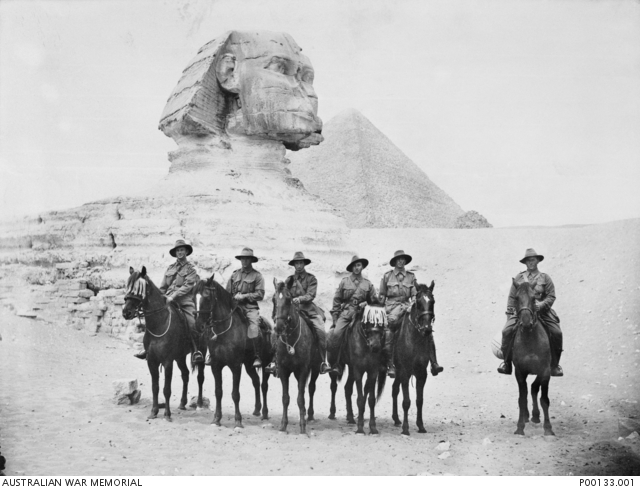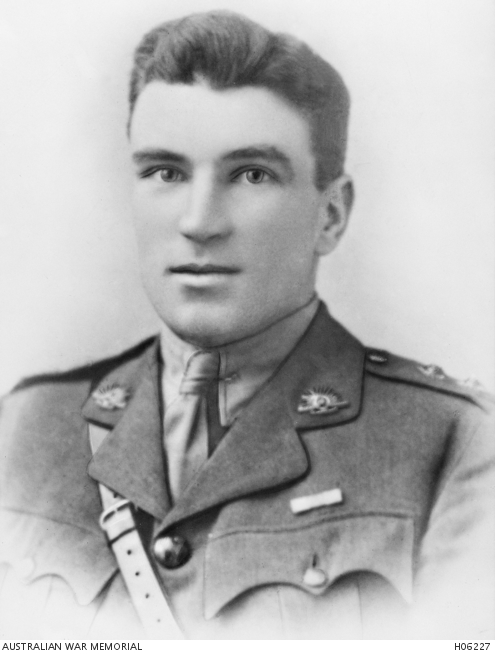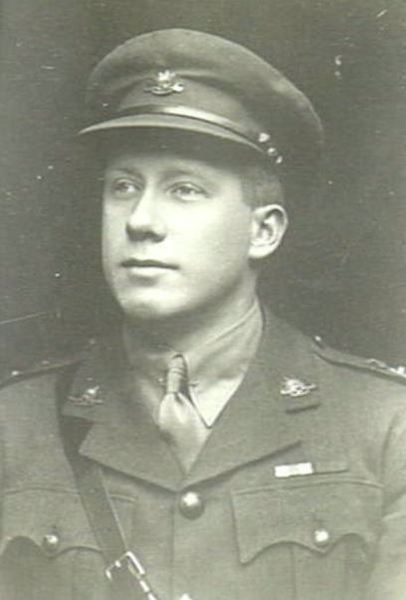W. Waite, MC and Bar
William Waite was born on September 27th, 1888 to Michael John [1860-1934] and Margaret [Nee Roberts/Robarts] Waite [1870-1936]
William Waite enlisted into the AIF on August 20th, 1914 at Broadmeadows and was given the service number 363. He trained there and was assigned to C Troop [O.C Lt Pollard], B Squadron [O.C Cpt Armstrong], 4th Light Horse Regiment, which was then commanded by Lieutenant Colonel John Keatly Forsyth who was tasked with raising the 1st Light Horse Brigade whilst the actual Commander [Col. Chauvel] was absent in England.
Lieutenant Colonel J.K Forsyth [later CMG] rose to the rank of Brigadier during the war
Lieutenant Stanley Fox Pollard
Captain Stephen John Wright Armstrong, later Major.
William's Regiment embarked from Melbourne on October 19th, 1914 on the S.S Wiltshire. He arrived in Mena Camp, Egypt on December 12th and trained there for 5 months. During this time, he was promoted to the rank of Lance Corporal [December 23rd, 1914], and then he was deployed onto Gallipoli on May 24th, 1915, just a month after the initial landings.
Members of the 4th L.H.R infront of the Sphinx
A photo taken by Waite on the Gallipoli Peninsula of the Padre
He was reverted to the ranks on July 16th for failing picquet duty but was appointed Lance Corporal again on August 2nd. Even though he had a bad start on the peninsula, he was promoted to Provost Corporal on August 27th, Corporal on September 28th, Provost Sergeant on November 4th, then Sergeant on November 27th. He disembarked at Alexandria on December 27th, the end of his time on the Peninsula. He embarked from Alexandria on March 21st, 1916, arriving in Marseilles on the 27th. On May 13th, he was taken onto strength with the 1st Australian & New Zealand Mounted Regiment in France. He transferred to the 2nd ANZAC Mounted Regiment on July 7th which probably led to his promotion to Second Lieutenant on September 9th. On September 22nd, he transferred to the 53rd Battalion which had taken heavy casualties 2 months earlier at Fromelles. On November 17th, Waite went to Divisional Training School, and came back on the 23rd. He then went to a Lewis Gun Instructors Course from January 15th to the 29th, 1917. During March and April 1917, he was recognized by the Brigade Commander, Brigadier C. J. Hobkirk. The Brigadier recommended him for a Military Cross, the recommendation reading...

"This officer took out strong patrols at night many times between 13th March and 5th April 1917. He performed exceptionally good work and showed great skill in the conduct of these patrols, thereby obtaining most valuable information which led to the entering of enemy lines at, and near TANSLOY, and started the advance of the whole line. The information obtained by this officer and his patrols was also very largely responsible for the successful attack on DOIGNIES and LOUVERVAL on April 2nd. This work entailed lying out close to, and sometimes inside, the enemy's wire on several wet nights in succession."
His MC appeared in the London Gazette on June 18th, 1917 on page 6005 at position 19

Brigadier Clarence John Hobkirk CMG, DSO
Newspaper, August 16th, 1917
He was promoted to 'Two-Pip' Lieutenant on April 15th, 1917 and went on 'Blighty Leave' on April 24th. He rejoined the Battalion on May 8th in France. He went to Hospital on June 25th with Appendicitis, and didn't come back to the 53rd until September 13th, a full 3 months. On September 26th, 1917 he was wounded at Polygon Wood, a gunshot wound in the left buttock. After some time at Sutton Veny, he was sentenced by a General Court Martial, reading..
"London 21-2-18. Committing a civil offence, that is to say uttering a forged document. Knowing the same to he forged. Pleading Not Guilty. Finding Guilty. Sentence to take rank + precedence in his corps & in the AIF as if his appointment as lt. back date 27-3-18. To be Severely Reprimanded 27-3-18."
*the forged document was a railway ticket
Lieutenant Waite M.C; Probably whilst in England, 1918.
He came back to France on the 6th June and distinguished himself at Peronne on September 1st, 1918.
At the time, he was a Company 2iC/Platoon Commander under Captain William Frederic Lindsay, Officer Commanding 'D' Company, 53rd Battalion. Captain Lindsay led his Company until he was wounded, probably after the initial wirebelt when they reinforced Major J. J. Murray's flank. Lieutenant Waite forced a passage through the wire throughout Heavy Artillery and Machine Gun Fire, and then protected an undefended flank which the Germans were attempting to exploit. At some point, he borrowed a Signaller by the name of [Private] Crank to operate a captured 77mm gun, earlier liberated by a Private Currey. Waite then later advanced with a party to the Sugar Factory, driving out the Germans. During this time, he was isolated from his forces. Waite was there for hours before artillery started shelling positions, and this prompted messages to be sent to the Sugar Factory for Waite to be recalled. At 3A.M, Private Currey volunteered to get the message through even after two failed attempts. Currey managed to get close enough and yell with all his power "Waitsy/Waitey, Get in!" This drew all the enemy fire towards him. Luckily for Currey, Waite had heard the message and began his withdrawal. Currey winded up gassed. Crank was given a Distinguished Conduct Medal whilst they gave Currey a Victoria Cross for capturing the 77mm gun and pulling Waite back.

Map of the battlefield. Waite is shown on the map.
Waite's official citation reads..
"For most conspicuous gallantry an devotion to duty in action. During the attack on Peronne on 1st September 1918 despite strong Enemy wire entanglements and Machine Gun and Artillery Barrage, Lieut. WAITE with his platoon forced a passage through the wire and moved forward to the attack. While the advance was in progress, the enemy was observed to be massing on the left which was an exposed flank, and Lieut. Waite despite heavy casualties brought his Platoon into action in the open and inflicted so many casualties in the enemies ranks that he was forced to disperse and allow the advance to continue.
In the second attack all the Officers of his Company became casualties, and he assumed Command, and established posts well forward, which he successfully held until ordered to withdraw by the Commanding Officer [Lieutenant Colonel Cheeseman].
He displayed the utmost gallantry, and such disregard of personal safety throughout, that he won the admiration of all ranks."
He was awarded a Bar to his Military Cross which appeared on the London Gazette on February 1st, 1919 on page 1638 at position 4.

Lieutenant Colonel Cheeseman
Captain William F. Lindsay, Off. Cmd. 'D' Coy, post-war. He was also awarded the Military Cross in the same action
Peronne in 1918, following the capture.
Before the war would end, he would go into hospital one more time on October 30th with appendicitis, returning to what remained of 'D' Company on November 6th.
D Company on Armistice Day 1918, from the collection of Lt Waite
NCO's of the 53rd Battalion on Armistice Day, from the collection of Lt Waite
Waite would embark home on January 11th on 'Orca' and arrive home on February 19th, 1919. His appointment would be terminated at 3rd M.D on June 6th, 1919 after 4 years and 10 months in the service. William Waite would later marry Hilda Cope in February 1926 and have a son, William 'Reg' Reginald Waite born on Remembrance Day, 1927. Waite was troubled by his buttock wound at Polygon Wood for many years following the war. He answered the call and enlisted for the Second World War on February 7th, 1941 and lowered his age by 2 years. He was taken onto strength of the 8th Garrison Battalion on December 17th, 1941 at Adamstown and was appointed Acting Sergeant the same day. He was further appointed Acting Lieutenant on January 16th, 1942 at Sydney. Unfortunately, his record from the Second World War ends there. William Waite would die on August 28th, 1976, somewhere in New South Wales, aged 87 years old.
Below is the medal set that he would've been entitled to;
Military Cross+Bar 1914-15 Star Victory Medal Australian Service Medal
British War Medal War Medal
Edited by tankengine888

15 Comments
Recommended Comments
Create an account or sign in to comment
You need to be a member in order to leave a comment
Create an account
Sign up for a new account in our community. It's easy!
Register a new accountSign in
Already have an account? Sign in here.
Sign In Now